
Ground spiders comprise Gnaphosidae, the seventh largest spider family with nearly 2,000 described species in over 100 genera distributed worldwide. There are 105 species known to central Europe, and common genera include Gnaphosa, Drassodes, Micaria, Cesonia, Zelotes and many others. They are closely related to Clubionidae. At present, no ground spiders are known to be seriously venomous to humans.

Lampshade spiders, family Hypochilidae, are among the most primitive of araneomorph spiders. There are two genera and twelve species currently recognized. Like mygalomorphs, most hypochilids have two pairs of book lungs, but like araneomorphs they have intersecting fangs, with the exception of some species which have chelicerae in an angle that is neither orthognathous or labidognathous. These long-legged spiders build typical "lampshade" style webs under overhangs and in caves. In the United States the fauna is primarily associated with the Appalachian, Rocky and California Mountains. Ten of the known species are found in these ranges, all in the genus Hypochilus. The genus Ectatosticta is found in China.
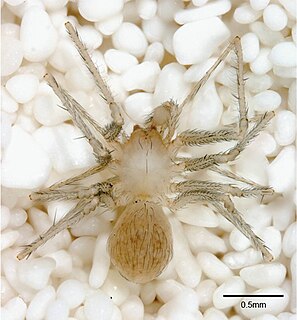
Leptonetidae is a relatively primitive family of spiders first described by Eugène Simon in 1890. It is made up of tiny haplogyne spiders, meaning they lack the hardened external female genitalia. Their six eyes are arranged in a semicircle of four in front and two behind. Many live in caves or in leaf litter around the Mediterranean, and in Eurasia, Japan and southern North America.

Norman Ira Platnick was an American biological systematist and arachnologist. At the time of his death, he was a Professor Emeritus of the Richard Gilder Graduate School and Peter J. Solomon Family Curator Emeritus of the invertebrate zoology department of the American Museum of Natural History. A 1973 Ph.D. recipient at Harvard University, Platnick described over 1,800 species of spiders from around the world, making him the second most prolific spider taxonomist in history, behind only Eugène Simon. Until 2014 he was also the maintainer of the World Spider Catalog, a website formerly hosted by the AMNH which tracks the arachnology literature, and attempts to maintain a comprehensive list, sorted taxonomically, of every species of spider which has been formally described. In 2007 he received the International Society of Arachnology's Bonnet award, named for Pierre Bonnet, in recognition of his work on the catalog.
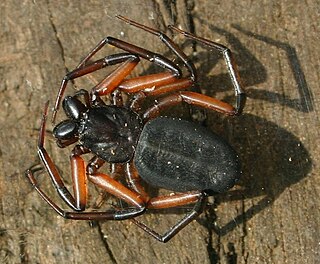
Trochanteriidae is a family of spiders first described by Ferdinand Karsch in 1879 containing about 180 species in 21 genera. Most are endemic to Australia though Doliomalus and Trochanteria are from South America and Olin and Plator are from Asia. Platyoides species exist in southern and eastern Africa, Madagascar, and the Canary Islands with one species, P. walteri, introduced to Australia.

Orsolobidae is a six-eyed spider family with about 180 described species in thirty genera. It was first described by J. A. L. Cooke in 1965, and was raised to family status from "Dysderidae" in 1985.

Stenochilidae is a family of southeast Asian araneomorph spiders that produce ecribellate silk. First described by Tamerlan Thorell in 1873, it now contains twelve described species in two genera.
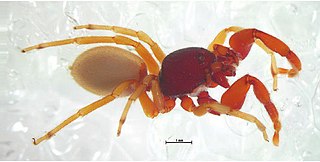
Palpimanidae, also known as palp-footed spiders, is a family of araneomorph spiders first described by Tamerlan Thorell in 1890. They are widely distributed throughout the tropical and subtropical regions of the world, the Mediterranean and one in Uzbekistan, but not Australia. They are not common and there is a high degree of endemism.
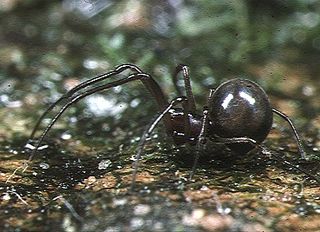
Anapidae is a family of rather small spiders with 231 described species in 58 genera. It includes the former family Micropholcommatidae as the subfamily Micropholcommatinae. Most species are less than 2 millimetres (0.079 in) long.
Calponia is a monotypic genus of araneomorph spiders in the family Caponiidae, containing the single species, Calponia harrisonfordi. It was first described in 1993 by Norman I. Platnick, who named the type species after the film actor Harrison Ford to thank him for narrating a documentary for the Natural History Museum in London. It has only been found in California in the United States.
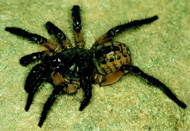
Liphistius is a genus of basal trapdoor spiders in the family Liphistiidae. They are found in Japan, China, and Southeast Asia.

Myrmekiaphila neilyoungi is a species of spider in the family Euctenizidae, described in 2007 by East Carolina University professor of biology Jason E. Bond and Norman I. Platnick, curator at the American Museum of Natural History in New York City. It is named after Canadian rock musician Neil Young.

Caponiidae is a family of ecribellate haplogyne spiders that are unusual in a number of ways. They differ from other spiders in lacking book lungs and having the posterior median spinnerets anteriorly displaced to form a transverse row with the anterior lateral spinnerets. Most species have only two eyes, which is also unusual among spiders. A few species of Caponiidae variously have four, six or eight eyes. In some species the number of eyes will increase when the spiderling changes its skin as it grows towards adulthood.
Eurymorion is a genus of South American dwarf spiders that was first described by Norman I. Platnick in 1993.
Novakiella is a genus of South Pacific orb-weaver spiders containing the single species, Novakiella trituberculosa that has only been found in Australia and New Zealand.
Benoitodes is a genus of ground spiders that was first described by Norman I. Platnick in 1993. As of May 2019 it contains only two species: B. caheni and B. sanctaehelenae.
Echemoides is a genus of South American ground spiders that was first described by Cândido Firmino de Mello-Leitão in 1938. Originally placed with the ant spiders, it was moved to the ground spiders in 1993.
Eilica is a genus of ground spiders that was first described by Eugen von Keyserling in 1891.
Myrmecomelix is a genus of South American dwarf spiders that was first described by Norman I. Platnick in 1993. As of May 2019 it contains only two species, both found in Ecuador and Peru: M. leucippus and M. pulcher.
Selenyphantes is a monotypic genus of sheet weavers containing the single species, Selenyphantes longispinosus. It was first described by Carl Eduard Adolph Gerstaecker & L. I. Davis in 1946, and has only been found in Guatemala and Mexico.











